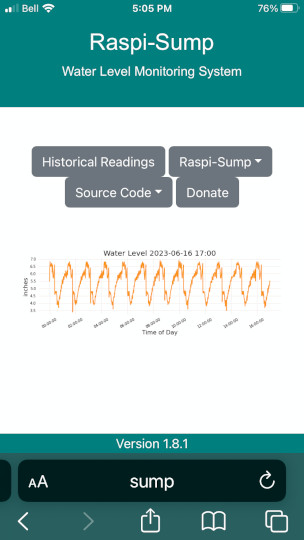A sump pit monitoring system for Raspberry Pi
Project description
Raspi-sump is a sump pit water level monitoring system using a Raspberry Pi and an Ultrasonic Sensor (HC-SR04).
Currently the system monitors the water level in your pit at defined intervals. It sends email sms alerts if the water reaches a critical level, indicating a possible sump pump failure.
What's New
See the changelog for the latest information on Raspi-Sump features.
Supported Versions of Raspbian / Raspberry Pi OS
Raspi-Sump is currently supported on Raspberry Pi OS (Bullseye) and Raspian (Buster)
Discord Group
Discuss and get support from other users. Email (alaudet@linuxnorth.org) for an invite link.
Install Dependencies
sudo apt install python3-pip python3-rpi.gpio python3-matplotlib
Install Raspi-Sump
Pip installs default to Wheels which omits some folder setup in setup.py. Always use the '--no-binary :all:' option when installing or upgrading Raspi-Sump with pip.
sudo pip3 install --no-binary :all: raspisump
Upgrading Raspi-Sump
Upgrading an existing version
sudo pip3 install -U --no-binary :all: raspisump
This will also install the HCSR04sensor
Read the configuration docs copied during setup on your pi at the following location;
/home/username/raspi-sump/docs
They are also available on github https://github.com/alaudet/raspi-sump/blob/master/docs/install.md
Python2 (End of Life was January 1, 2020)
Python2 installs of Raspi-Sump are no longer supported.
More Info
Further details provided at https://www.linuxnorth.org/raspi-sump/
An example hourly updating graph is available for view. https://www.linuxnorth.org/raspi-sump/raspi-sump-today.html
Disclaimer
You are welcome to use Raspi-Sump but there is no guarantee it will work. Your house may still flood if your sump pump fails. This software comes with no warranty. See License details.
This is not a replacement for a properly maintained water pumping system. It is one tool you can use to give yourself extra piece-of-mind.
Best practices should include:
- A backup pump that triggers at a slightly higher water level than your main pump.
- The secondary pump should be connected to a seperate dedicated electrical breaker.
- You should also have a generator that can provide power should you have an extended outage during the spring or other unseasonally wet time of year.
- if you are building a new home, pay attention to the grade of your property, as you may be able to let gravity empty your pit for you. That would be the best approach with a backup pump for added protection.
Once you have done all of these things, then consider using a monitoring system like Raspi-Sump.
License
MIT License. I want you to do whatever you want with Raspi-Sump. If you improve it please let me know.
Contributing
Please refer to the Contributing Guidelines before issuing a pull request.
Donate
Project details
Release history Release notifications | RSS feed
Download files
Download the file for your platform. If you're not sure which to choose, learn more about installing packages.












